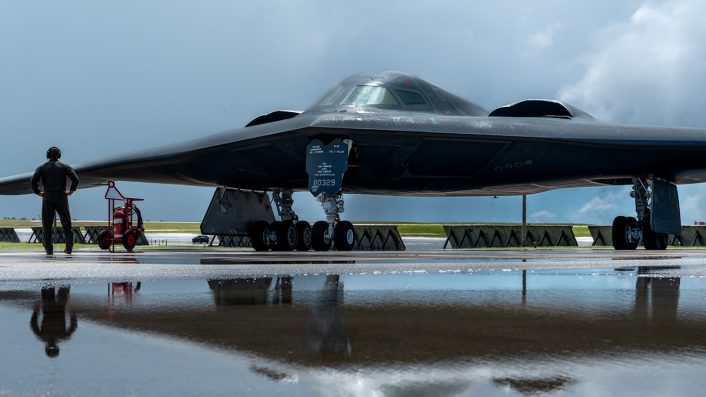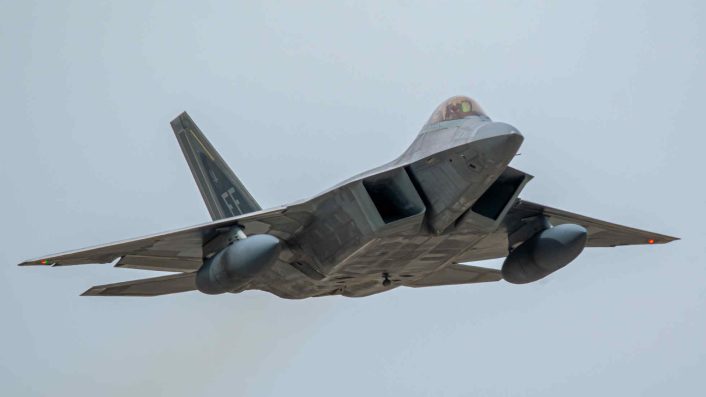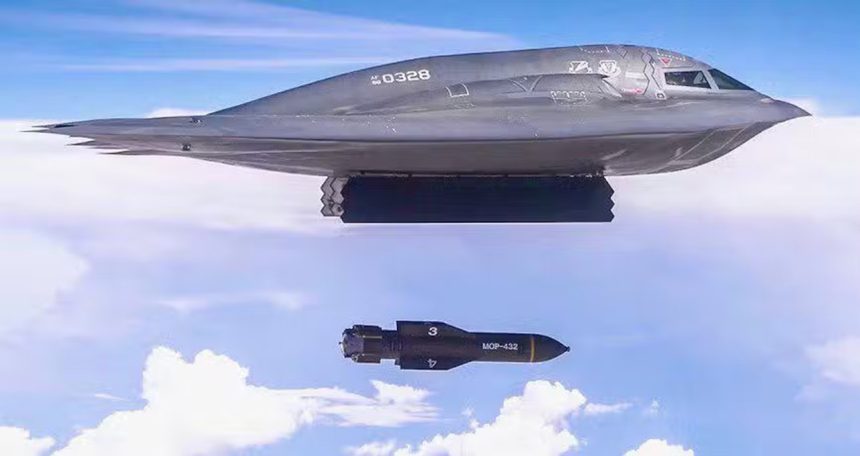While most reporters were focused on the B-2 heading to Guam, the actual strike package was already flying east over the Atlantic Ocean toward its targets in Iran.
Few days after the mobilization of U.S. combat airpower to the Middle East, the United States joined the Israeli war against Iran. On Jun. 22, 2025, U.S. President Donald Trump announced the strike against Iranian nuclear sites, including Fordow, Natanz and Esfahan.
President Donald J. Trump has announced strikes were carried out tonight by the U.S. Air Force against the Fordow, Natanz, and Isfahan Nuclear Facilities in Iran. pic.twitter.com/4L9g2Y990V
— OSINTdefender (@sentdefender) June 21, 2025
The President said the primary site was Fordow, which was hit “by a full payload of bombs,” and all aircraft are now out of Iranian airspace. He did not state which aircraft conducted the attack, however U.S. officials speaking on condition of anonymity told Reuters that the B-2 Spirit bombers were the aircraft involved in the raid.
Two flights of B-2 Spirits, callsigns MYTEE 11 flight and MYTEE 21 flight, each comprising three aircraft, departed from Whiteman Air Force Base, Missouri, in the early hours of Jun. 21, 2025. Their destination was confirmed as Andersen Air Force Base, located on the Pacific island of Guam, rather than the Indo-Pacific outpost of Diego Garcia.
However, it looks like these bombers were part of a deception strategy: it is in fact becoming clear that the bombers involved in the attack did not take the west route but flew eastbound.
What a distraction!
Send B-2s publicly westbound to Guam, confirmed by DoD officials early today, while other B-2s went eastbound to carry out the strike.
Now it’s time to see how Iran and its proxies respond. https://t.co/WeNy0bxmAa
— TheIntelFrog (@TheIntelFrog) June 22, 2025
An aviation enthusiast living in Missouri posted on X that what he believe were 9 B-2s were overflying Warsaw, Missouri, heading east.
Seems possible if not probable that while every open-source reporter in the world was watching very public and eventually government-confirmed B-2 flights westward, a guy in his backyard in Missouri saw the real, undisclosed and untracked mission heading east https://t.co/fFd2pkRSyk
— Evan Hill (@evanhill) June 22, 2025
Therefore, while most of reporters were watching the B-2 flying to Andersen – a deployment officially confirmed – the actual strike package (probably including in-flight spares) was flying eastbound towards the Atlantic Ocean to strike Iran.
In the end, 6 B-2A Spirit bombers dropped the bunker buster bombs on the Iranian nuclear facilities.
CNN is now reporting that 6 B-2A “Spirit” Long-Range Stealth Bombers with the U.S. Air Force dropped a total of 12, not 6, GBU-57A/B MOP (Massive Ordnance Penetrator) 30,000lb “Bunker Buster” Bombs on the Fordow Nuclear Facility in Central Iran. In addition, U.S. Navy submarines… pic.twitter.com/oK5FvL0dAW
— OSINTdefender (@sentdefender) June 22, 2025
Split into two sections, a total of 7 B-2s (most probably 6 + 1 airborne spare) were monitored as they flew back to Whiteman AFB after the raid.
Seven B-2s calling SEVILLE CONTROL on VHF over the Straight of Gibraltar on their way back from Iran this morning after refueling over the Mediterranean Sea.
BATT 11 flt (x4 B-2) – advises ATC destination Barksdale AFB
BATT 21 flt (x3 B-2) pic.twitter.com/XYNAyPRXQG
— Thenewarea51 (@thenewarea51) June 22, 2025
The eastbound route also explains the recent deployment of numerous U.S. tanker aircraft to Morón, Spain.
You don’t sit that many tankers for that many days and have it not for something. https://t.co/AhSMFGz9n0
— Evergreen Intel (@vcdgf555) June 22, 2025
Interestingly, the Fordow mission was rehearsed many times, according to former B-2 pilot.
Former B-2 pilot and No. 2 at Global Strike retired Lt. Gen. Mark Weatherington says the Fordow mission has been reheased “many times for several years.”
— Lucas Tomlinson (@LucasFoxNews) June 22, 2025
There are also reports about heavy degradation across the electromagnetic spectrum in Iran. This might be explained by the presence of EA-18G Growlers in the strike package to support the aircraft involved.
Reports out of Iran right now of some of the most heavy wide spectrum jamming of the war, radios, GPS, and cell all experiencing heavy degradation.
Most likely US electronic warfare supporting strikes.
— OSINTtechnical (@Osinttechnical) June 21, 2025
A short video allegedly shows Fordow engulfed in flames after the strike. However, it is being reported that it might have been recorded during previous Israeli strikes.
Despite what many accounts on X right now are claiming, this video is old and not from tonight’s U.S. strikes against the Fordow Nuclear Facility nor any other strikes tonight against Iran. pic.twitter.com/wg9aJqWOM5
— OSINTdefender (@sentdefender) June 22, 2025
First satellite imagery showing some entry holes in the area of the Fordow underground facility was released in the morning on Jun. 22, 2025.
The first image of Fordow has now been released, a set of munition entry holes are visible just above the suspected underground facility while signs of land subsidence is seen, possibly as the area of interest caved inwards as result of the strike pic.twitter.com/Fsl7Rc7lBn
— Damien Symon (@detresfa_) June 22, 2025
On 21 June 2025, President Trump announced the US had struck Iran’s Fordow Nuclear Facility with GBU-57A/B MOP bunker busting bombs. High-resolution imagery taken on 22 June 2025 shows the site after it had been struck. pic.twitter.com/iXid2djIgU
— Open Source Centre (@osc_london) June 22, 2025
The strike
Details about the U.S. strike in Iran are still limited. President Trump told Fox News‘ Sean Hannity that a total of six GBU-57 Massive Ordnance Penetrator (MOP) bunker buster bombs have been dropped on Fordow, the main target. The Natanz and Isfahan facilities were not struck by the bombers, but they were instead attacked by using 30 BGM-109 Tomahawk Land Attack Missiles (TLAM) fired by unspecified U.S. submarines.
Sean Hannity reports 6 bunker busting bombs were dropped on Fordow from USAF B-2 bombers. Isfahan and Natanz targeted with Tomahawk cruise missiles from submarines.
— Lucas Tomlinson (@LucasFoxNews) June 22, 2025
President Trump tells @seanhannity that 6 MOP 30,000 lb bunker buster bombs were dropped on Fordow. And 30 TLAM Tomahawk missiles were fired by US submarines at Natanz and Isfahan, destroying all 3 nuclear facilities completely.
— Jennifer Griffin (@JenGriffinFNC) June 22, 2025
Each B-2 can carry up to two GBU-57s, according to the U.S. Air Force. It is unclear, however, how many aircraft were part of the strike and thus whether they carried one or two bombs each.

Similarly, it is currently unclear how the strike package was structured. Even if Iranian air defenses were already highly degraded by the Iranian strikes, the strike package might have involved at the very least F-22 Raptors, F-35 Lightning IIs, EA-18G Growlers and, obviously, the B-2s. The U.S. Air Force has also F-15E Strike Eagles and F-16 Fighting Falcons which might have joined the mission.
According to the New York Times, a U.S. official speaking on condition of anonymity said that initial damage assessments indicate that Fordow has been “taken off the table.” Fox News reported that Israel already “damaged 75% of the Natanz and Isfahan facilities” and the Tomahawks “finished the job.”
According to a source who spoke with Fox News, Israel damaged 75% of the Natanz and Isfahan Nuclear Facilities, with U.S. strikes using BGM-109 “Tomahawk” Land-Attack Cruise Missiles (TLAMs) tonight “finishing the job.”
— OSINTdefender (@sentdefender) June 22, 2025
GBU-57 MOP
Among the B-2’s unique capabilities is the ability to carry the huge GBU-57 Massive Ordnance Penetrator (MOP) bunker buster bomb, which is thought to be the only conventional weapon able to hit the most hardened of Iran’s nuclear facilities. This weapon would have been the weapon of choice for the strikes against the three Iranian nuclear sites, although some raised the question whether the sites were too deep underground even for the MOP.
The GBU-57 Massive Ordnance Penetrator (MOP) is a 30,000-lb (14,000 kg), 20-foot long GPS-guided bomb said to be able to penetrate 200 feet of concrete before exploding. The weapon is exclusively available to the B-2 Spirit, which can carry two MOPs in its internal bomb bay.
The development was commissioned following the 2003 Iraq War, where existing bunker buster bombs were found to be inadequate for the most hardened structures. The U.S. Air Force describes the weapons’ function as “reaching and destroying our adversaries’ weapons of mass destruction”.
This makes the GBU-57 the weapon of choice in case of attack on buried targets, such as the Iranian bunkers where the nuclear program is being worked on. It is being reported that the two biggest uranium enrichment sites in Iran are the Fuel Enrichment Plant at Natanz, located about three floors underground, and Fordow, dug far deeper into a mountain.
Also, one of the shots gives a pretty clear shot of the weight and types of fillers in the bomb. 4400 lbs of AFX-757, an explosive recently developed by the AFRL for use in penetrating bombs, & 762 (752?) lbs of PBXN-114 for a total of ~5,162 lbs of HE filler. 2/2 @FranticGoat pic.twitter.com/mzuXGwKTWk
— IntelWalrus (@IntelWalrus) May 3, 2023
The secretive weapon has been upgraded in the early 2010s and, although the type of upgrades it received were not made public, it was reportedly equipped with new fusing and tail fins needed to give it greater ground penetration. Sources report that the GBU-57 has GPS/INS guidance and a large penetrator smart fuse to allow the warhead to reach a set depth before triggering the explosion.
Images of the MOP are pretty rare, with only a few released throughout the years. In 2013, we published here an interesting photo of a B-2 sitting next to a GBU-57. In December 2018, we found footage of a B-2 dropping a MOP in a video of the 393rd Bomb Squadron, one of the units that operate the Spirit stealth bomber as part of the 509th BW.
In April 2023, the 131st BW posted some photos including one depicting an inert GBU-57, used for training purposes. A month later, the 509th BW posted new photos, this time showing a live GBU-57.

The preparations
In the night between June 15 and 16, 2025, multiple U.S. Air Force KC-135 and KC-46 aerial refueling aircraft departed their bases in the United States headed to Europe. The sudden and unusual movement was quickly noticed on flight tracking websites, when about 30 tankers were first spotted headed towards the Atlantic Ocean and later arriving in Europe.
Most of these aircraft landed at Ramstein Air Base in Germany and at Morón Air Base and NAS Rota in Spain, while two landed at Aviano Air Base in Italy, one landed at Prestwick International Airport in the UK and three at Souda Bay in Greece. Multiple tankers have also been spotted at Lajes Air Base, in the Azores, which is another location commonly used to support flights over the Atlantic Ocean.
The first reports of the imminent deployment of F-22s and F-35s surfaced on Jun. 17, following the tankers’ relocation. These reports came as U.S. Secretary of Defense Pete Hegseth “directed the deployment of additional capabilities to the United States Central Command Area of Operations.”
Soon thereafter, reports surfaced about F-22 Raptors preparing to depart from Langley Air Force Base, Virginia, to deploy to the CENTCOM AOR. Few hours later, it was reported that F-35s departed from RAF Lakenheath, supported by KC-135s from RAF Mildenhall and Morón Air Base.

F-16 Fighting Falcons from Aviano Air Base, in Italy, were also moved to the CENTCOM AOR, although that was reportedly a planned deployment. Additionally, after the USS Nimitz aircraft carrier was sent to the Middle East to join the USS Carl Vinson, the USS Gerald R. Ford is set be deployed to the Mediterranean.
We previously mentioned that it might be possible the U.S. could decide to move to the area more assets, such as fighter jets, as deterrent against attacks on its bases in the Middle East. In fact, U.S. President Donald Trump warned Iran against attacks against U.S. forces.
According to CBS News, former U.S. President Donald Trump already approved military plans for a potential strike against Iran, although he did not yet to decide whether to act on them. Citing an intelligence source, the report stated that Trump held back from launching the attacks in hopes that Tehran might abandon its nuclear ambitions.
The report came amid growing speculation following remarks from Iran’s Supreme Leader Ali Khamenei, who dismissed Trump’s demands. Trump responded on Truth Social, saying The Wall Street Journal had “no idea what my thoughts are concerning Iran,” without directly addressing whether the strike plans had been approved.
Later on, on Jun. 20, Trump said he would have decided within two weeks whether to launch the strike. Two days later, Iranian targets have been struck by U.S. aircraft.
This is a developing story, we will update this article as new details emerge.









